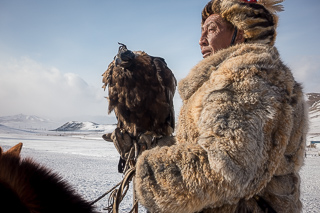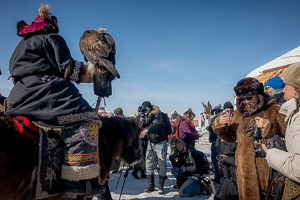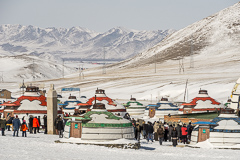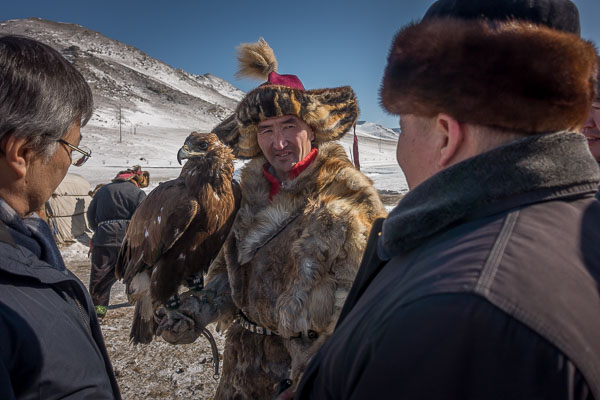Eagle Festival

When Eagles Choose Your Clothes
Mongolia's isolation comes from its deserts and mountains, its lack of roads or cities in most of the country. Even including the Inner Mongolian region of China, the once powerful Mongol empire is left with only several million people sharing its common language. Within Mongolia is a small minority of ethnic Khazakhs, who mostly live in the western part of the country. And among Khazakhs, there is a much smaller group who have maintained the tradition of raising and training golden eagles for use in hunting. Before polyester fiber, nylon and microfleece was shipped from China in trucks, eagles were working with humans to find animals whose skins could be used to keep the Khazaks warm in the brutal winter of the western mountains. The need to hunt has declined as these cheap man-made alternatives have flourished, and without this practical need the number of people practicing eagle hunting declines, to the point where it is hard to find young Khazaks interested in continuing the practice just to uphold a cherished tradition.

Photo Op, Eagle Festival
On Saturday morning I took a bus south and then west on Chingis Avenue, to Eagle Festival 2016 with my friend Batjargal. We arrived at the Chingis Khan Ger Camp shortly after eleven, in time to see a couple dozen fur-covered men mount horses, eagles clinging to their heavily gloved right arms, then ride up the valley and out of sight. After several long (it is -18°C, around 0°F) speeches by officials in front of an oversized central restaurant-ger, the eagle hunters made their re-entry, riding single file to a spot up the hill from the large ger before descending to a space carved out of the crowd by police with yellow tape. There were more speeches as photographers in the crowd jockeyed for the best position from which to photograph the eagle hunters.

Eagle Festival 2016, Chingis Khan Ger Camp
Old hunters and young are aware and unflinching before a camera, and they exhibit a calm skill and devotion to their birds. But they must also be aware that each of the hundreds of visitors has paid 20,000 tugrigs ($10 USD) to see them. Training eagles, not to mention eagle hunters, is a long, time-intensive process. Without the attention and the money these hunters gain it will be ever more difficult to attract new apprentices.
Despite the crowds, it is still a treat and privilege to watch these magnificent birds and the partnership they have with their handlers. (Khazaks do not use the word owner, because they will return the birds to the wild when they reach eight or nine years old.) Although there were several events held at this festival, the two main competitive events involving eagles might be compared to events at dog obedience school. The first was the come and sit event, where a hunter leaves his eagle with another handler and rides down the hill and calls for the bird. When all goes well, the eagle takes to the air and swoops to a landing on the hunter's forearm. The other large event was much like a fetch or retrieve—the carcass of a fox or marmot is dragged down the hill behind the hunter and the bird is released from the top of the hill with the hope that it will tackle the dragged animal. While there were many successful entrants, there were also those that reminded us that these are wild animals, that they have minds of their own, and that no matter how good the relationship between bird and hunter, it is one that can't be taken for granted. Batjargal explained an announcer's warning, in Mongolian, to pay attention to small children and pets. Eagles have been known to find them attractive as prey.
